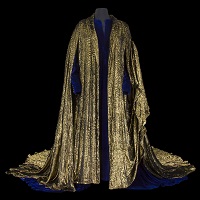
Deep in the heart of France, the little-known town of Moulins (Auvergne) reveals the fabric of great theater at the National Costume Museum.
***
Before asking yourself whether you want to be, or not to be, in Moulins, you’ll quite naturally ask yourself, as I once did, “O Moulins, Moulins, wherefore art thou Moulins.” For Moulins is an unlikely destination in the hinterlands of France that’s difficult to situate on the map. Being told that the towns of Bourges, Vichy, Nevers, Autun and Montluçon are within a radius of 60 miles only vaguely helps.
Ah, there you are, Moulins. Come, let’s away.
The thought of taking the train 2.5 hours from Paris to visit a museum dedicated to theatrical costumes did little in itself to get my travel juices flowing. Yet, accustomed to following the rails southeast and southwest from Paris, it felt strangely venturesome to ride due south beyond the Loire. I say there is no darkness but ignorance. Actually Shakespeare said that. But I was ignorant of Moulins, capital of the department of Allier and of the former duchy of the Bourbon family known as Le Bourbonnais. So I took this trip as a challenge to discover something new for myself while exploring an unheralded region.
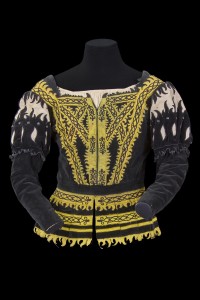
Moulins has since 2006 been home to the National Costume Center, Centre National du Costume de Scène or CNCS. In the world of theater, the CNCS is unique in its devotion to preserving, studying and exhibiting exceptional and histsorical theater costumes and elements of theater sets. Much of the collection comes from three founding institutions, the Comédie Française, the National Library (BNF) and the National Opera of Paris. The center also receives donations from costume designers, theaters, acting companies and artists and their heirs. Its vast collection of 10,000 costumes and another 10,000 articles largely remains in the on-site reserves. Choice items are then brought out thematically for evocative, even dramatic, temporary exhibits mounted twice yearly.
In 2014 the CNCS honors the 450th anniversary of Shakespeare’s birth with the exhibition Shakespeare, l’étoffe du monde (the fabric of the world), presenting costumes, mostly from French productions over the past century, of some of the bard’s most emblematic plays.
The exhibition begins by introducing visitors to the world of Elizabethan theater, then displays in a dozen rooms the diversity of Shakespeare’s world through the costumes of kings, queens, soldiers, jesters, witches, cross-dressing actors and assorted ghosts and spirits. The exhibition runs through Jan. 4, 2015.
Information about this and upcoming exhibitions can be found here.
O, had I but followed the arts!

It’s rare for France’s Ministry of Culture to allow a national collection to stray far from Paris, but the relative obscurity of theater costumes and the knowledge that the conservation of the vast collection required significant space, led to its removal from the capital region. For Moulins, a service town with a population of 27,000, 40,000 with the suburbs, the center’s creation here in 2006 was a coup that placed it on the cultural radar of the map of France.
Moulins is capital of the department of Allier and of the former duchy of the Bourbon family but had no particular historical relationship with theatrical costumes, unless one counts the uniforms of the cavalrymen who occupied the exhibition building when originally built as barracks in the late 18th century. The architect Jacques Denis Antoine (1733-1801) also designed the old mint (Hôtel des Monnaies) in Paris near Pont Neuf on the left bank of the Seine.
The CNCS is a 20-minute walk from the center of Moulins, on the left bank of the Allier, past the terns nesting along the river from April to early August. (The name Moulins refers to the mills that were once here.) On the approach the building appears rather sparse and uninviting. But the CNCS is appropriately theatrical in the presentation of its exhibitions, and there’s a nice airy brasserie inside.
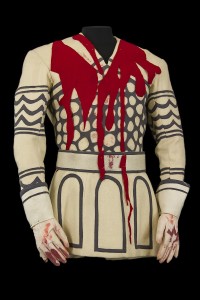
While much of the CNCS’s public space is dedicated to its temporary exhibitions, the center also presents a permanent exhibition of the Noureev (Nureyev) Collection. That exhibition displays artifacts from the life and career of Rudolf Noureev (Nureyev) (1938-1989) the danceur étoile who, in the 1980s, danced with the Paris Opera Ballet and became its director (1983-1989).
In addition to its exhibitions, the CNCS is an important resource center open to stage professionals, researchers and the general public.
Shall I compare thee, Moulins, to a summer’s day?
Perhaps not, but the sun needn’t be at its peak for the curious traveler to visit a lesser-known region such as Moulins and its surrounding.
* * *
The building blocks for making a day or more of Moulins and the surrounding area of Le Bourbonnais include the following:
National Center for Theatrical Costumes and Scenography, Centre National du Costume de Scène. Tel. 04 70 20 76 20. Open daily 10am-6pm (until 6:30pm in July and Aug.). Closed Dec. 25 and Jan. 1. Tickets: 6€ for entrance to both the temporary and permanent exhibitions. Free for children under 12. For several weeks between exhibitions only the permanent collection is visible.
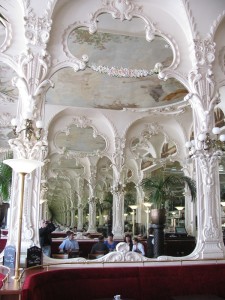
Moulins Tourist Office. 11 rue François Péron. Tel. 04 70 44 14 14
Choice café: Le Grand Café, 49 Place Allier. Tel. 04 70 44 00 05. An Art Nouveau café-brasserie whose 1899 décor is listed as a historical monument. Open Mon.-Sat. 8am-11pm.
Choice restaurants:
– Le Grand Café (see above)
– Le 9/7, 97 rue d’Allier. Tel. 04 70 35 01 60. Olivier Mazuelle serves fresh market fare in the center of town. Closed Sat. lunch, Sun., Mon. dinner.
– Le Trait d’Union, 16 rue Gambetta. Tel. 04 70 34 24 61. Trait d’union, meaning hyphen, refers to the link that chef Vincent Hoareau seeks to create a link between classicism with modernity. Closed Sun., Mon.
– Hôtel de Paris (see below).
Choice hotel: Hotel de Paris, 23 rue de Paris. Tel. 04 70 44 00 58. A 4-star hotel with 32 rooms and suites, AC, spa, gastronomic restaurant (opening Sept. 2014), brasserie. Member of Chateaux & Hotels Collection.
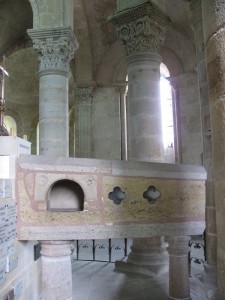
Others sight in Moulins:
– Maison Mantin (Mantin Mansion). The home of an upper-class resident (a bourgeois) of the late 19th-century left more or less as it was and according to his will.
– The flamboyant Gothic Notre-Dame Cathedral of Moulins and its late 15th-century/early 16th-century triptych of the Virgin of the Apocalypse.
– Le Jacquemart, a15th-century belfry.
Near Moulins:
– Souvigny and its Romanesque abbey church containing the tombs of the Dukes of Bourbon.
– Saint Menoux Church, another beautiful Romanesque church, and its legend that sticking ones head in the hole of the saint’s tomb will render the simple-minded more intelligent.
– Bourbon-l’Archambault, an old spa town containing ruins of a fortified castle.
– Vineyards of Saint-Pourçain, a little-known appellation using Gamay and Pinot Noir for the reds and rosés and Chardonnay, Sauvignon and Tressallier (a local grape) for the whites.
See this companion article about sights, food and drink in Moulins and the surrounding region: Tasted, Tested in Allier.
© 2014, Gary Lee Kraut


Gary – Is there any place in France where you haven’t been?
Plenty. And plenty of places to revisit.